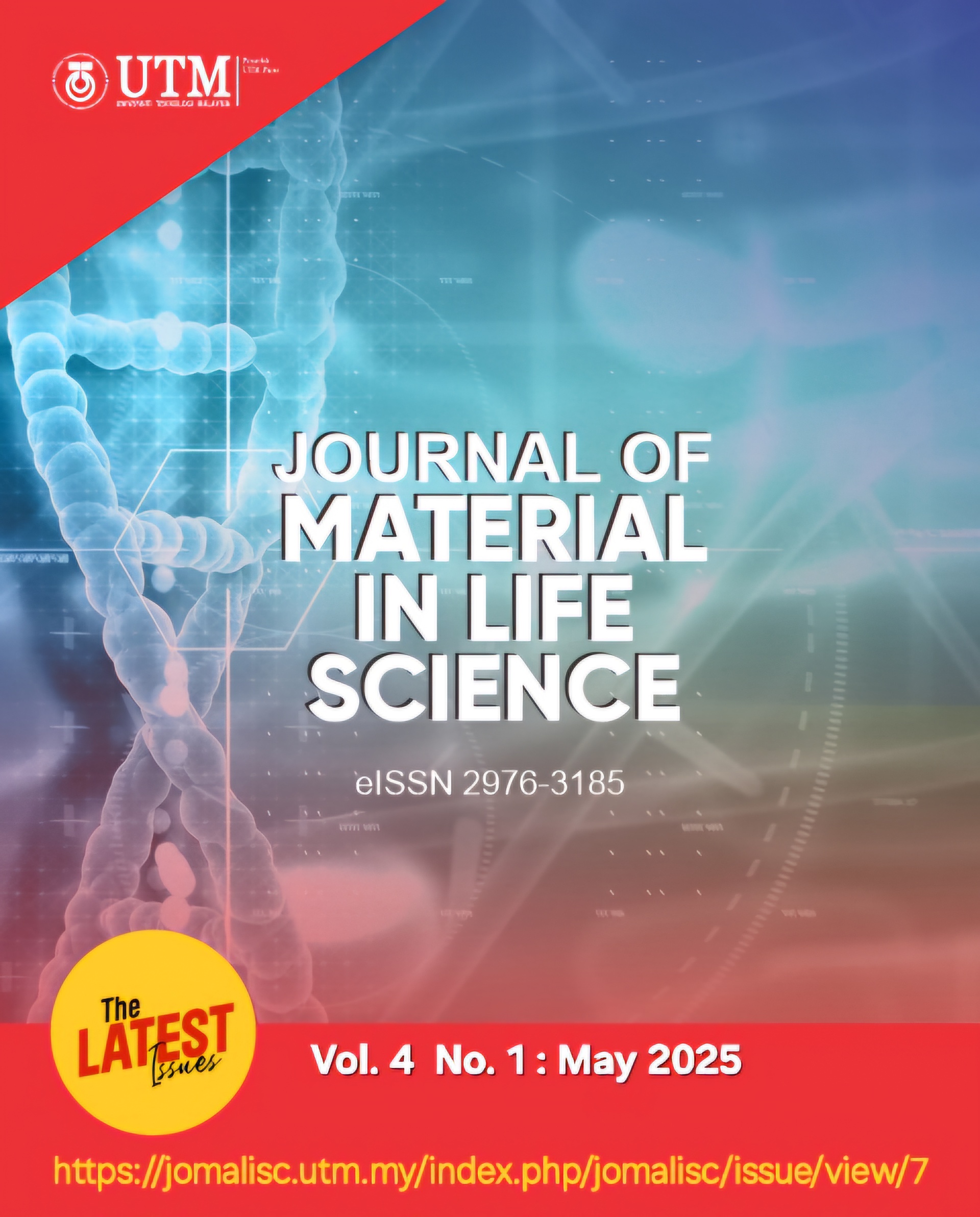Synthesis and Characterizations of Novel Mesostructured TUD-C supported Copper-doped Titanium Dioxide Photocatalyst
DOI:
https://doi.org/10.11113/jomalisc.v4.87Keywords:
TUD-C, Titanium dioxide, copper, mesoporous, photocatalystAbstract
Titanium dioxide (TiO2) has garnered extensive application as a photocatalyst owing to its excellent chemical stability and cost-effectiveness. Nonetheless, its practical efficiency is hindered by several intrinsic limitations, including a relatively wide band gap, rapid recombination of photoinduced electron-hole pairs, and a limited surface area, all of which significantly diminish its photocatalytic efficiency. To address these shortcomings, a series of novel copper-doped titania supported on Technische Universiteit Delft-Crystalline (TUD-C), denoted as xCu-TiO2/TUD-C (x = 0.1–1.0 mol%), were synthesized. The fabrication of these materials was achieved through a multistep process, involving sol-gel synthesis, hydrothermal treatment, wet impregnation, and calcination. Powder X-ray diffraction (PXRD) analysis confirmed that the TiO2 component crystallized in the anatase phase. Additionally, PXRD verified that the TUD-C support retained the Modernite Framework Inverted (MFI) zeolitic structure, along with a high specific surface area ranging between 270 and 321 m²/g. The successful incorporation of Cu-doped TiO2 onto the TUD-C support was validated through energy-dispersive X-ray (EDX) elemental analysis. Furthermore, diffuse reflectance ultraviolet-visible (DRUV-Vis) spectroscopy revealed a noticeable reduction in band gap energies for the 0.1, 0.5, and 0.7 mol% Cu-TiO2/TUD-C samples, which exhibited values of 2.93 eV, 3.06 eV, and 2.77 eV, respectively, lower than that of undoped TiO2 (3.29 eV). These findings underscore the promising potential of the synthesized Cu-TiO2/TUD-C materials as efficient visible-light-responsive photocatalysts for the degradation of various organic contaminants.
References
Eddy, D. R., Sheha, G. A. N., Permana, M. D., Saito, N., Takei, T., Kumada, N., Irkham, Rahayu, I., Abe, I., Sekine, Y., Oyumi, T., & Izumi, Y. (2024). Study on triphase of polymorphs TiO₂ (anatase/rutile/brookite) for boosting photocatalytic activity of metformin degradation. Chemosphere, 351, 141206. https://doi.org/10.1016/j.chemosphere.2024.141206
Wang, Y. Y., Chen, Y. X., Barakat, T., Zeng, Y. J., Liu, J., Siffert, S., & Su, B. L. (2022). Recent advances in non-metal doped titania for solar-driven photocatalytic/photoelectrochemical water-splitting. Journal of Energy Chemistry, 66, 529–559. https://doi.org/10.1016/j.jechem.2021.08.038
Wong, W. D., Majnis, M. F., Lai, C. W., Sagadevan, S., & Julkapli, N. M. (2024). Enhancement of mixing and reaction efficiency of various fluids applications at different microfluidic configuration and design. Chemical Engineering and Processing - Process Intensification, 198, 109729. https://doi.org/10.1016/j.cep.2024.109729
Ling, C. M., Teng, C. C., Hatta, M. H. M., & Lee, S. L. (2021). Tungsten oxide doped titania supported on TUD-C for photocatalytic removal of methylene blue. Platform: A Journal of Science and Technology, 4(2), 42–52. https://doi.org/10.61762/pjstvol4iss2art13217
Ling, C. M., Yuliati, L., Lintang, H. O., & Lee, S. L. (2020). TUD-C-supported tungsten oxide-doped titania catalysts for cyclohexane oxidation. Malaysian Journal of Chemistry, 22(2), 29–36.
Molahalli, V., Sharma, A., Bijapur, K., Soman, G., Shetty, A., Sirichandana, B., Patel, B. M., Chattham, N., & Hegde, G. (2024). Copper-based nanomaterials in organic transformations. Washington, DC: American Chemical Society.
He, L., Yang, Z., Xu, Y., Lu, X., Kaba, S., Li, C., Yao, X., Xu, D., & Yao, Z. (2024). Copper doped UiO-66@TiO₂ heterojunction for highly efficient photodegradation of odors in broiler houses. Journal of Cleaner Production, 451, 142103. https://doi.org/10.1016/j.jclepro.2024.142103
Albaidani, K., Timoumi, A., Belhadj, W., Alamri, S. N., & Ahmed, S. A. (2023). Structural, electronic and optical characteristics of TiO₂ and Cu-TiO₂ thin films produced by sol-gel spin coating. Ceramics International, 49(22), 36265–36275. https://doi.org/10.1016/j.ceramint.2023.08.309
Yang, Y., Shen, H., Ma, C., Li, D., Ma, B., Lu, Y., & Wang, Y. (2024). Preparation of C@CuNi/TiO₂ with a local surface plasmon resonance for photocatalytic degradation of organic dyes and antibiotics under visible light irradiation. Colloids and Surfaces A: Physicochemical and Engineering Aspects, 703, 135406. https://doi.org/10.1016/j.colsurfa.2024.135406
Duan, L., Lin, Q., Peng, H., Lu, C., Shao, C., Wang, D., Rao, S., Cao, H., & Lv, W. (2023). The catalytic reduction mechanisms of metal-doped TiO₂ for nitrate produced from non-thermal discharge plasma: The interfacial photogenerated electron transfer and reduction process. Applied Catalysis A: General, 650, 118995. https://doi.org/10.1016/j.apcata.2022.118995
Ooi, Y. K., Hussin, F., Yuliati, L., & Lee, S. L. (2019). Comparison study on molybdena-titania supported on TUD-1 and TUD-C synthesized via sol-gel templating method: Properties and catalytic performance in olefins epoxidation. Materials Research Express, 6(7), 074001. https://doi.org/10.1088/2053-1591/ab12be
Ooi, Y. K., Yuliati, L., Hartanto, D., Nur, H., & Lee, S. L. (2016). Mesostructured TUD-C supported molybdena doped titania as high selective oxidative catalyst for olefins epoxidation at ambient condition. Microporous and Mesoporous Materials, 225, 411–420. https://doi.org/10.1016/j.micromeso.2016.01.016
Nikitha, N., Raguram, T., Rajni, K. S., & Kuppusamy, M. (2025). Impact of Sn-Sr co-doping on structural, morphological and optical properties of TiO₂ for solar energy conversion applications. Optik, 328, 172332. https://doi.org/10.1016/j.ijleo.2025.172332
Nagarani, S., Sasikala, G., Yuvaraj, M., Kumar, R. D., Balachandran, S., & Kumar, M. (2022). ZnO-CuO nanoparticles enameled on reduced graphene nanosheets as electrode materials for supercapacitors applications. Journal of Energy Storage, 52, 104969. https://doi.org/10.1016/j.est.2022.104969
Saffari, M., Kavousi, Z. H., Ghorbanloo, M., Nada, A. A., Bekheet, M. F., Bezzerga, D., Hong, J., Morsali, A., Holade, Y., Viter, R., & El-Maghrabi, H. H. (2024). Copper benzene-1,3,5-tricarboxylate based metal organic framework (MOF) derived CuO/TiO₂ nanofibers and their use as visible light active photocatalyst for the hydrogen production. Applied Surface Science, 678, 161061. https://doi.org/10.1016/j.apsusc.2024.161061
Raguram, T., & Rajni, K. S. (2022). Synthesis and characterisation of Cu-doped TiO₂ nanoparticles for DSSC and photocatalytic applications. International Journal of Hydrogen Energy, 47(7), 4674–4689. https://doi.org/10.1016/j.ijhydene.2021.11.113
Huang, Q., Lou, X., Nie, D., Zhao, Z., Fan, K., Guo, W., Meng, J., Liu, Z., & Han, Z. (2024). Accelerated photodegradation of T-2 toxin over magnetic recyclable ZnO/CaFe₂O₄ nanocomposite with a pn based Z-scheme heterojunction architecture. Separation and Purification Technology, 347, 127518. https://doi.org/10.1016/j.seppur.2024.127518
Cheng, Z., Zheng, Q., Duan, Y., Cai, M., & Zhang, H. (2024). Effect of subcritical water temperature on the structure, antioxidant activity and immune activity of polysaccharides from Glycyrrhiza inflata Batalin. International Journal of Biological Macromolecules, 261, 129591. https://doi.org/10.1016/j.ijbiomac.2024.129591
Aslam, S., Subhan, F., Waqas, M., Zifeng, Y., Yaseen, M., & Naeem, M. (2023). Cu nanoparticles confined within ZSM-5 derived mesoporous silica (MZ) with enhanced stability for catalytic hydrogenation of 4-nitrophenol and degradation of azo dye. Microporous and Mesoporous Materials, 354, 112547. https://doi.org/10.1016/j.micromeso.2023.112547


















